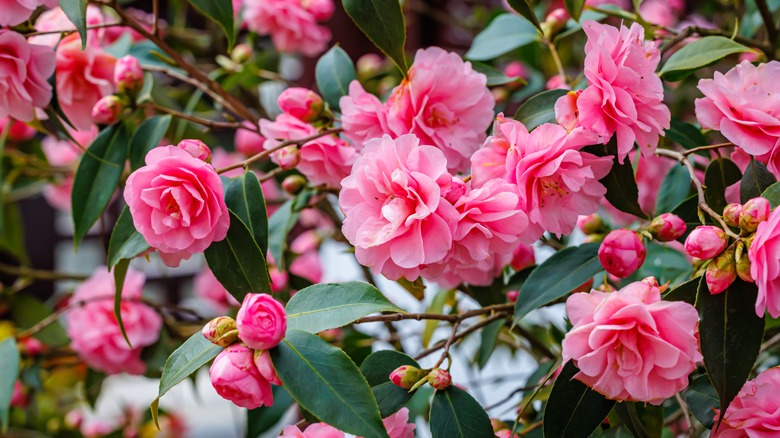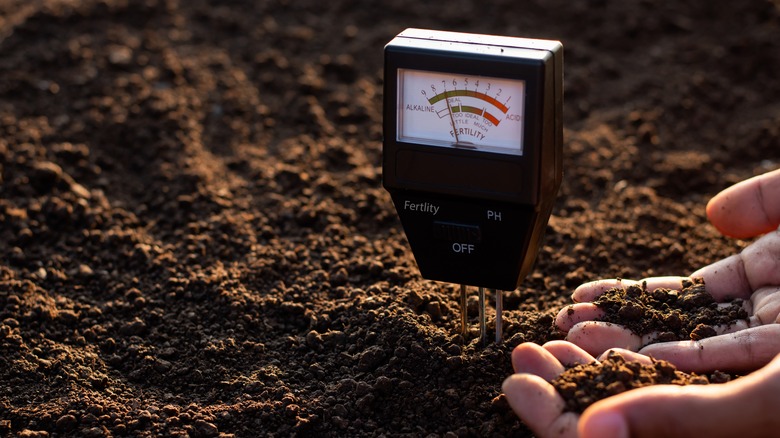TikTok Shares The Secret Ingredient You Need To Grow Thriving Camellias
Camellias are flowering plants known for their colorful, lush blooms and glossy, evergreen leaves. Native to eastern and southern Asia, these ornamental plants range in color from pure white to pink and deep red. Camellias require slightly acidic soil that allows them to absorb essential nutrients effectively. This ericaceous nature means they can be vulnerable to iron deficiency when grown in soils that are too alkaline. Iron sulfate can be used to remedy a deficiency or lower soil pH, supporting the health and vibrancy of your camellias.
Camellias typically bloom from winter to spring. The large, showy flowers come in an array of forms — including single, semi-double, double, and peony— making them a versatile choice for any garden or floral arrangement. Camellias prefer well-drained, acidic soil, and do best in partial sun or filtered sunlight. Known for being relatively low maintenance, even beginners can learn how to take care of camellia plants.
Why is iron sulfate beneficial to camellias?
Ericaceous (acid-loving) plants, such as camellias, thrive in acidic soils with a pH typically between 4.5 and 6. Iron is less available in neutral and alkaline soils, particularly within a pH range between 7.5 and 8.5. Plants that are native to regions with neutral or alkaline soils can extract the iron they need to grow. However, camellias have evolved to absorb iron in acidic conditions. If the soil pH is too high, they struggle to access this essential nutrient — this limitation makes them susceptible to iron deficiency.
Iron sulfate serves a dual purpose for camellias and other ericaceous plants: it can provide a nutritional boost of iron and can also acidify alkaline soils. Also known as ferrous sulfate, iron sulfate is a chemical compound composed of iron as well as sulfur — a common acidifying material for alkaline soils. This dual action can not only remedy iron-deficient camellias but also enhance the acidity of soils to ensure they have access to the nutrients they need. Consider testing the pH of your soil to help diagnose the cause of an iron deficiency in your camellias and to best provide optimal conditions for growth.
How to apply iron sulfate to camellias
In camellias that are iron-deficient, the younger leaves will exhibit yellowing in between the veins, known as interveinal chlorosis. Applying iron sulfate as a foliar spray is a great option to treat early symptoms, allowing the plant to absorb iron directly through the leaves. Dissolve 1 to 2 ounces of iron sulfate into 1 gallon of water and spray directly onto the affected leaves. Take care to avoid spraying in windy weather or during the middle of the day, when the sun can cause leaf scorch.
To treat the soil directly and increase acidity, the same solution can be watered into the base of the plant. Apply this solution once a week to treat an iron deficiency and then every four to six weeks once the camellia is revived. To acidify slightly alkaline soil in the garden, iron sulfate powder can be incorporated into the soil before planting at a rate of 32 to 63 ounces per square yard. It is worth considering that for gardens with alkaline soil, camellias may be best grown in pots with an ericaceous potting mix that provides the correct pH for nutrient availability. Tiktok content creator @oldgardenideas shows how to apply the iron sulfate to a potted plant, noting that with it, "Camellias will grow strongly." Note that for soil that is already acidic, applying iron sulfate will not be necessary.

